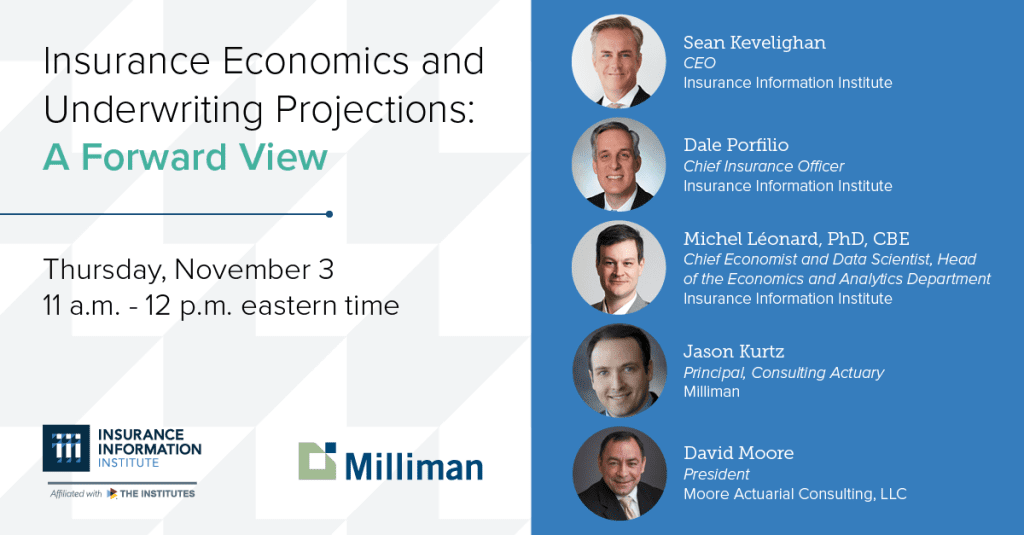Ian, Personal Auto, Inflation, Geopolitics Driving Worst P&C Underwriting Results Since 2011

The property/casualty insurance industry’s underwriting profitability is forecast to have worsened in 2022 relative to 2021, driven by losses from Hurricane Ian and significant deterioration in the personal auto line, making it the worst year for the P&C industry since 2011, actuaries at Triple-I and Milliman – an independent risk-management, benefits, and technology firm – reported today.
The quarterly report, presented at a members-only webinar, also found that workers compensation continued its multi-year profitability trend and general liability is forecast to earn a small underwriting profit, with premium growth remaining strong due to the hard market.
The industry’s combined ratio – a measure of underwriting profitability in which a number below 100 represents a profit and one above 100 represents a loss – worsened by 6.1 points, from 99.5 in 2021 to 105.6 in 2022.
Rising rates, geopolitical risk
Dr. Michel Léonard, Triple-I’s chief economist and data scientist, discussed key macroeconomic trends impacting the property/casualty industry, including inflation, replacement costs, geopolitical risk, and cyber.
“Rising interest rates will have a chilling impact on underlying growth across P&C lines, from residential to commercial property and auto,” he said, adding that 2023 “is gearing up to be yet another year of historical volatility. Stubbornly high inflation, the threat of a recession, and increases in unemployment top our list of economic risks.”
Léonard also noted the scale of geopolitical risk, saying, “The threat of a large cyber-attack on U.S. infrastructure tops our list of tail risks.”
“Tail risk” refers to the chance of a loss occurring due to a rare event, as predicted by a probability distribution.
“Russia’s weaponization of gas supplies to Europe, China’s ongoing military exercises threatening Taiwan, and the potential for electoral disturbances in the U.S. contribute to making geopolitical risk the highest in decades,” Léonard said.
Cats drive underwriting losses
Dale Porfilio, Triple-I’s Chief insurance officer, discussed the overall P&C industry underwriting projections and exposure growth, noting that the 2022 catastrophe losses are forecast to be comparable to 2017.
“We forecast premium growth to increase 8.8 percent in 2022 and 8.9 percent in 2023, primarily due to hard market conditions,” Porfilio said. “We estimate catastrophe losses from Hurricane Ian will push up the homeowners combined ratio to 115.4 percent, the highest since 2011.”
For commercial multi-peril line, Jason B. Kurtz, a principal and consulting actuary at Milliman – a global consulting and actuarial firm – said another year of underwriting losses is likely.
“Underwriting losses are expected to continue as more rate increases are needed to offset catastrophe and economic and social inflation loss pressures,” Kurtz said.
For the commercial property line, Kurtz noted that Hurricane Ian will threaten underwriting profitability, but that the line has benefited from significant premium growth. “We forecast premium growth of 14.5 percent in 2022, following 17.4 percent growth in 2021.”
Regarding commercial auto, Dave Moore, president of Moore Actuarial Consulting, said the 2022 combined ratio for that line is nearly 6 points worse than 2021.
“We are forecasting underwriting losses for 2023 through 2024 due to inflation, both social inflation and economic inflation, loss pressure, and prior year adverse loss development,” he said. “Premium growth is expected to remain elevated due to hard market conditions.”
“After a sharp drop to 47.5 percent in 2Q 2020, quarterly direct loss ratios resumed their upward trend, averaging 74.2 percent over the most recent four quarters,” Porfilio said. “Low miles driven in the first year of the pandemic contributed to favorable loss experience.”
Since then, Porfilio continued, “Miles driven have largely returned to 2019 levels, but with riskier driving behaviors, such as distracted driving, and higher inflation. Supply-chain disruption, labor shortages, and costlier replacements parts are all contributing to current and future loss pressures.”
Overall, loss pressures from inflation, risky driving behavior, increasing catastrophe losses, and geopolitical turmoil are leading to the need for rate increases to restore underwriting profits.




